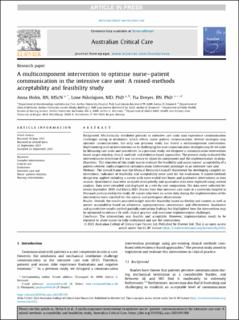| dc.contributor.author | Holm, Anna | |
| dc.contributor.author | Nikolajsen, Lone | |
| dc.contributor.author | Dreyer, Pia | |
| dc.date.accessioned | 2022-02-21T12:38:21Z | |
| dc.date.available | 2022-02-21T12:38:21Z | |
| dc.date.created | 2021-12-02T16:34:05Z | |
| dc.date.issued | 2021 | |
| dc.identifier.issn | 1036-7314 | |
| dc.identifier.uri | https://hdl.handle.net/11250/2980517 | |
| dc.description.abstract | Background
Mechanically ventilated patients in intensive care units may experience communication challenges owing to intubation, which affects nurse–patient communication. Several strategies may optimise communication, but only one previous study has tested a multicomponent intervention. Implementing such an intervention can be challenging because communication strategies may be set aside by lifesaving care tasks and procedures. In a previous study, we designed a communication intervention based on pre-existing clinical methods and evidence-based approaches. The present study evaluated the intervention to determine if it was necessary to adjust its components and the implementation strategy.
Objectives
The objective of this study was to evaluate the feasibility and assess nurses’ acceptability of a patient-centred, multicomponent communication intervention prototype in an intensive care unit.
Methods
The overall frame was the Medical Research Council's framework for developing complex interventions. Indicators of feasibility and acceptability were used for the evaluation. A mixed-methods design was applied including a survey with open-ended text boxes and qualitative observations as data sources. Quantitative data were analysed descriptively, and qualitative data were explored using content analysis. Data were compiled and displayed in a side-by-side comparison. The data were collected between September 2020 and March 2021. Nurses from four intensive care units at a university hospital in Denmark participated in the study. All nurses who were on active duty during the implementation of the intervention were enrolled for the survey and participant observations.
Results
Overall, the results provided insight into the feasibility based on fidelity and context as well as nurses’ acceptability based on adherence, appropriateness, convenience, and effectiveness. Qualitative and quantitative results yielded partially contrasting findings but highlighted how the intervention may be optimised to enhance fit with clinical practice and overcome implementation challenges.
Conclusion
The intervention was feasible and acceptable. However, implementation needs to be repeated to allow nurses to fully understand and use the intervention. | en_US |
| dc.language.iso | eng | en_US |
| dc.publisher | Elsevier | en_US |
| dc.rights | Navngivelse 4.0 Internasjonal | * |
| dc.rights.uri | http://creativecommons.org/licenses/by/4.0/deed.no | * |
| dc.title | A multicomponent intervention to optimise nurseepatient communication in the intensive care unit: A mixed-methods acceptability and feasibility study | en_US |
| dc.type | Journal article | en_US |
| dc.type | Peer reviewed | en_US |
| dc.description.version | publishedVersion | en_US |
| dc.rights.holder | Copyright 2021 Australian College of Critical Care Nurses Ltd | en_US |
| cristin.ispublished | true | |
| cristin.fulltext | original | |
| cristin.qualitycode | 1 | |
| dc.identifier.doi | 10.1016/j.aucc.2021.09.008 | |
| dc.identifier.cristin | 1963748 | |
| dc.source.journal | Australian Critical Care | en_US |
| dc.identifier.citation | Australian Critical Care, 2021. | en_US |

